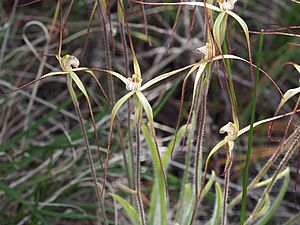Brookton Highway spider orchid facts for kids
Quick facts for kids Brookton Highway spider orchid |
|
|---|---|
 |
|
| Caladenia fluvialis near Pingelly | |
| Scientific classification | |
| Genus: |
Caladenia
|
| Species: |
fluvialis
|
| Synonyms | |
|
Caladenia sp. 'Brookton Highway' |
|
The Brookton Highway spider orchid (scientific name: Caladenia fluvialis) is a special type of orchid found only in the south-west part of Western Australia. It was discovered not too long ago. This orchid has one fuzzy leaf and usually one or two creamy-yellow flowers. These flowers have cool red patterns on their bottom lip, called the labellum.
Contents
What Does It Look Like?
The Brookton Highway spider orchid is a plant that grows from an underground tuber (like a small potato). It can sometimes grow in small groups. Each plant has one straight, hairy leaf. This leaf is about 7 to 13 centimeters (3 to 5 inches) long and 3 to 5 millimeters (0.1 to 0.2 inches) wide. It's pale green with some light purple spots near its base.
The orchid usually has one or two creamy-yellow flowers. These flowers are quite big, about 5 to 10 centimeters (2 to 4 inches) long and 7 to 11 centimeters (3 to 4 inches) wide. They grow on a stem that is about 12 to 25 centimeters (5 to 10 inches) tall.
Flower Parts
- Dorsal sepal: This is the top part of the flower, standing straight up. It's about 5 to 8 centimeters (2 to 3 inches) long.
- Lateral sepals: These are the two side parts of the flower. They are also about 5 to 8 centimeters long. They spread out at first, then curve downwards.
- Petals: These are similar to the sepals and spread out to the sides. They are about 5 to 7 centimeters (2 to 3 inches) long. Both the lateral sepals and petals have dark tips.
- Labellum: This is the special "lip" of the orchid, about 8 to 12 millimeters (0.3 to 0.5 inches) long. It's white with dark red markings. The sides of the labellum have short, blunt "teeth." Its tip curves downwards. There are also two rows of anvil-shaped bumps, called calli, along its center.
This orchid blooms, or flowers, during August and September.
How It Got Its Name
The Brookton Highway spider orchid, or Caladenia fluvialis, was first officially described in 2015. It was named by two scientists, Andrew Phillip Brown and Garry Brockman. They found a sample of the orchid near a place called West Dale in Western Australia.
The second part of its scientific name, fluvialis, comes from a Latin word. It means "of a river." This name was chosen because this orchid likes to grow in wet places, often near creeks.
Where Does It Live?
This special orchid grows in Western Australia, in the areas between Williams and York. You can find it in moist soils, especially in creeks that only have water at certain times of the year (called ephemeral creeks). It also likes to grow near large granite rocks.
Is It Protected?
The Government of Western Australia's Department of Parks and Wildlife has looked at the Brookton Highway spider orchid. They have classified it as "not threatened." This means that, for now, there are enough of these orchids, and they are not in danger of disappearing.


